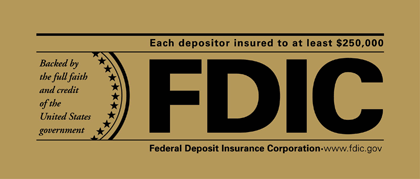Symbol of Confidence
Each depositor insured to at least $250,000
The Federal Deposit Insurance Corporation is an independent federal agency created in 1933 to promote public confidence and stability in the nation's banking system.
Throughout its history, the FDIC has provided bank customers with prompt access to their insured deposits whenever an FDIC-insured bank or savings association has failed.
In the FDIC's history, no customer has ever lost a single penny of insured deposits.
The FDIC official teller sign posted at every insured bank and savings association across the country - is a symbol of confidence for depositors.

Customers know, when they see the FDIC official teller sign, that they will get back all of their insured deposits in the unlikely event their insured bank or savings association should fail.
- How FDIC Insurance Works
- Basic Insurance Limit
- When a Bank Fails
- FDIC's Deposit Insurance Fund
- Full Faith and Credit of U.S. Government
- For More Information About FDIC Deposit Insurance Coverage
FDIC Insurance Works
Insurance is automatic whenever a customer opens any type of deposit account at an FDIC-insured bank or savings association, including checking, NOW and savings accounts, money market deposit accounts, and certificates of deposit (CDs). Insured banks and savings associations pay the FDIC for deposit insurance coverage.
The FDIC does not insure investments in stocks, bonds, mutual funds, life insurance policies, annuities, or municipal securities, even if a customer purchases them from an FDIC-insured bank or savings association.
Insurance Limit
The basic insurance limit is $250,000 per depositor at each insured bank and savings association.
If you have less than $250,000 in your deposit accounts, you do not need to worry; your funds are fully covered.
If you have more than $250,000 at one FDIC-insured institution, you should know that deposit accounts in different ownership categories are separately insured. This means you might qualify for more than $250,000 in coverage.
To learn more about the FDIC's insurance coverage rules, refer to the resources listed at the end of this pamphlet, or visit the FDIC's Web site at www.fdic.gov.
When a Bank Fails
The FDIC pays depositors within just a few days after an insured institution fails, usually the next business day. The FDIC protects depositors in one of two ways - by either:
- Facilitating a merger with another FDIC-insured institution, or
- Issuing a check to each depositor for the insured portion of their accounts at the closed institution.
FDIC's Deposit Insurance Fund
The FDIC is funded by its member institutions through premiums and assessments paid on deposits. And, if ever needed, the FDIC can draw on a line of credit with the U.S. Treasury.
Full Faith and Credit of U.S. Government
FDIC deposit insurance is backed by the full faith and credit of the United States government. This means that the resources of the United States government stand behind FDIC-insured depositors.
For More Information About FDIC Deposit Insurance Coverage
- Calculate
Your insurance coverage using the FDIC's Electronic Deposit Insurance Estimator - Read
Your Insured Deposits and other deposit insurance information - Call toll free
1-877-ASK-FDIC (1-877-275-3342) from 8 am until 8 pm (Eastern Time) Monday through Friday
Deaf or Hard of Hearing Line: 1-800-925-4618 - Email questions
Visit FDIC's Home Page and use the on-line Customer Assistance Form - Mail questions to
Federal Deposit Insurance Corporation
Attn: Deposit Insurance Outreach Group
550 17th Street, NW
Washington, DC 20429-9990

